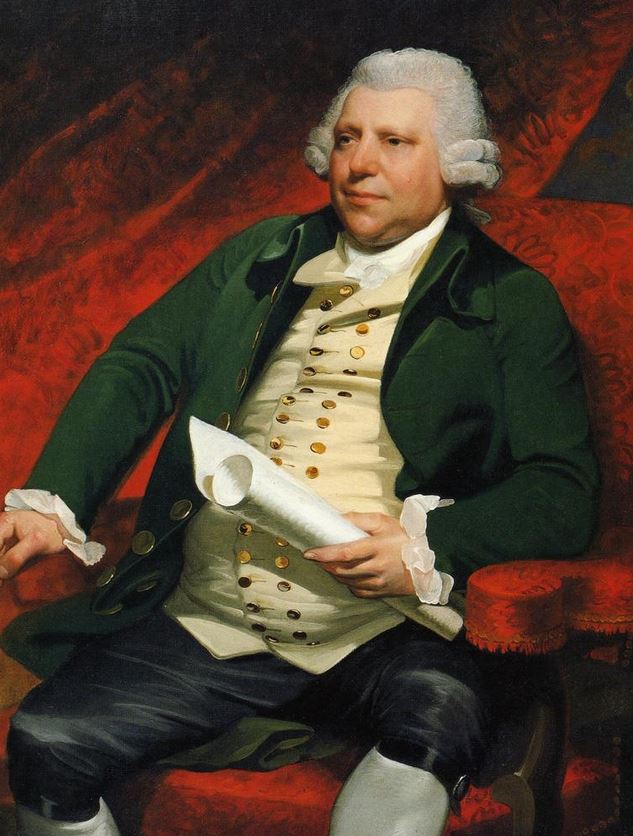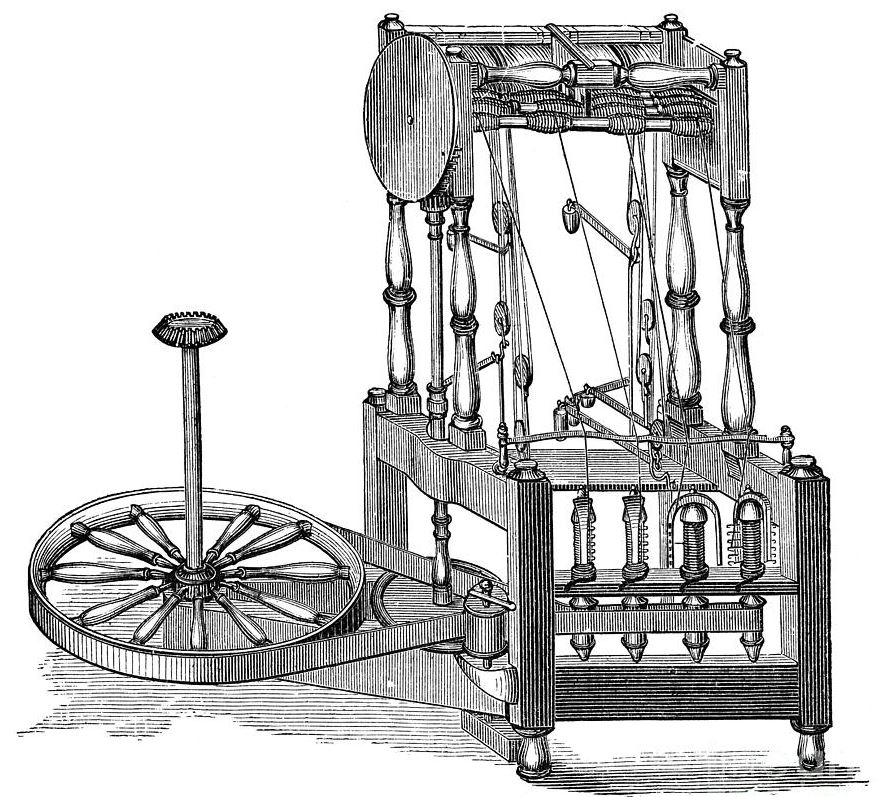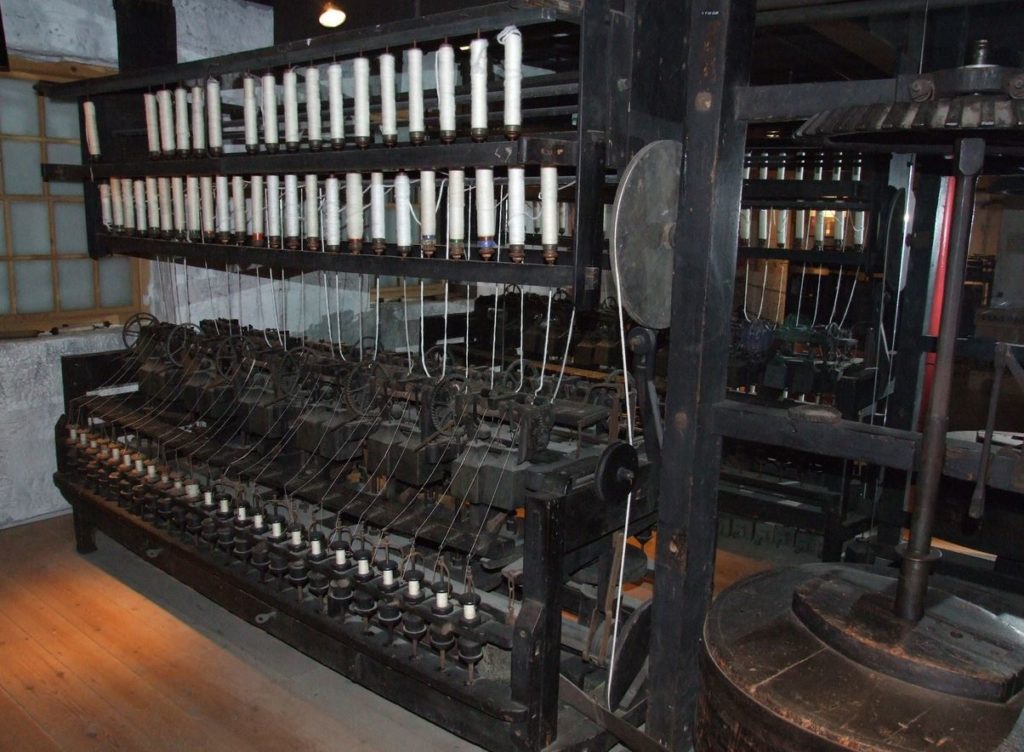In 1769, a machine was patented by Richard Arkwright that would see him go from wig maker to industrial tycoon. His Water Frame brought hydropower to spinning machines, which would enable the devices to turn hundreds of threads into high-quality, low-cost fabrics. His invention was one of the most significant innovations within the textile industry. Unfortunately, the process was entirely automated which also resulted in the exploitation of child labor.

The life of Sir Richard Arkwright
Arkwright’s life development was an interesting one. When he was young, he aspired to become a wig maker. After working with Spinning Frames, he saw the opportunity to move into the textile industry. It was this mentality that enabled him to invent the Water Frame and influence the world at the time. The Water Frame was one of the most significant inventions from the Industrial Revolution. It improved upon John Kay’s Spinning Jenny, increasing the productivity of the machines without the need for human labor.
Richard Arkwright was born into a large family. He was the youngest of the thirteen children. Only seven of them survived. Richard was born on the 23rd of December, 1732, in Preston, Lancashire. His father, Thomas, was a tailor and a Preston Guild burgess. The family was quite poor, which was exacerbated by the fact that there were many children to feed. Richard had to do without formal elementary education; instead, he was taught at home by his cousin Ellen.
This education was enough for him to learn how to read and write. He had no desire to follow his father’s footsteps as a tailor. He leaned towards being a barber and later a wig maker. It was in this field already that he made some exciting inventions.
Aspiring wig maker
In his teens, Richard started an apprenticeship with a barber where Richard would learn the ropes about the business. He eventually moved to Kirkham and started working for Mr. Nicholson as a barber. Later he became a wig maker. He stayed in Kirkham for a few years before moving to Bolton.
There, in 1750, he started working as a barber in Edward Pollit’s shop. His stay at Pollit’s barbershop was not a long one. Richard was only willing to work on his terms as he wanted to do something different. He saw an opportunity in wig making business. He decided to set up a business in 1754 in Bolton.
Richard Arkwright always had a mentality for inventions. Even in his shop, he always looked for improvements to tools and technology.
It was in Bolton where he met Patience Holt, who he later married in 1755. Patience was the daughter of a schoolmaster. Together, they had only one child – Arkwright named his first son after him. Unfortunately. Patience passed away in 1756, leaving Richard alone with his child. After his wife’s death, Richard was determined to invent something new. He wanted to do this to earn more money and provide for his son.
Remarriage and travel around the country
For a few years after his wife’s death, Richard kept working as a barber. He started studying the art of making wigs. Richard would collect people’s hair and analyze it. In 1761, he met his second wife-to-be, Margaret Biggins. Together, they have three children, but only his eldest daughter would survive childhood.
With this marriage, Richard managed to obtain a decent amount of money, which allowed him to expand his business. He started to become increasingly involved in wig making. In 1762, Arkwright collected enough money to start traveling around the country. On his travels, he continued collecting people’s hair, which may seem strange today. But more importantly, he met many new and influential people from the wig making and textile industry.
Upon returning to Bolton, Arkwright started working on a new method of dying hair for wigs. He thought that the hair wigs weren’t waterproof enough and not resistant to adverse weather conditions. So he developed a way of protecting and dying hair. He then patented the process.
Arkwright’s growing interest in the textile industry
The wig-making business was on the decline. People were no longer interested in wearing wigs. Hair wigs were out of fashion by the time Arkwright managed to patent his waterproofing process. Richard still managed to make a reasonable sum of money from his invention. He also knew it was time to shift his focus to something more profitable.
Arkwright kept traveling around the country, looking for new investment opportunities. From 1765 to 1767, Arkwright would spend most of his time meeting acquaintances, and looking for new ventures.
It was becoming apparent to him that the textile industry was booming. He started looking for skilled weavers and spinners who knew more about the business than himself. As he began to invest in new ideas, Arkwright became an entrepreneur.
He heard in 1762 that someone was looking to make a Spinning Frame. He started exploring this idea and learning more about the concept and who was behind it. In 1767, Arkwright met John Kay, a clockmaker and an inventor who was working on this new concept.
Sir Richard Arkwright and the Water Frame
Arkwright was aggressive as a businessman, so he looked to develop his version of the invention. John Kay, who was working on the spinning frame for some time with his friend, Thomas Highs, was looking for an investor that would push the invention forward. It was the perfect partnership for both parties. Kay and Highs were working on the Spinning Frame for almost a decade, but they never had the financial power to patent the idea in order to turn it into reality.
In 1767, Arkwright decided that he would help the pair with the invention. He was the pushing force behind it, providing Kay with the financial backing as well as the entrepreneurship skills that were required. Arkwright saw a gold mine in this invention, and how right he was. It was this invention that made the names Arkwright, Kay, and Highs famous. The spinning frame was almost ready in 1767, although it needed some further financial investment and some minor improvements.
In 1769, the spinning frame was not yet complete, but Arkwright saw the need to patent the invention to gain the rights to it. Many competitors were looking to steal the idea, so he wanted to patent it before he released it to the public. In 1769, Arkwright patented the Spinning Frame.

How did the Spinning Frame work?
Arkwright commissioned Kay and Highs to create the Water Frame for him. The Spinning Frame, or the Water Frame because a water source powered it, was much more efficient than all previous equipment that was in use during that time.
A Spinning frame used three sets of spinning rollers that turned at various speeds. These rollers would produce a yarn that was thicker and stronger than all thread that was in use before. It would stretch the threads so that it was easier to spin. The yarn then went through spindles to produce a fabric that was far more compact, stretchable, and stronger than ever before. A single spinning frame was able to hold 128 threads of yarn at the same time which made the production of fabric faster. At the same time, the spinning frame was self-sufficient and didn’t require an operator. This efficiency reduced the cost of the textiles produced by the Water Frame.
The whole concept was very revolutionary for the time, and it changed the way the textile industry operated. Workers were no longer required, or at least, not as many as before. At the same time, the high level of quality was more consistent. Productivity increased significantly with the introduction of the Water Frame. As the output numbers grew, the costs of textiles began to decrease.
But the Spinning Frame was still not wholly patented; this time, it was Arkwright that would require financial aid. Two entrepreneurs named Need and Strutt provided additional funding. The pair owned a knitting business, and they saw the opportunity to expand their business with the Spinning Frame. They finally patented the Water Frame by the end of the year 1769.

The Introduction of the Water Wheel
The Spinning Frame still had a few difficulties and shortcomings. The biggest weakness of the initial design was that it was too large to be operated by hand or by a single worker. Arkwright and the others started to look for solutions.
They first started experimenting with horses. They used horsepower to power the machine, but the power output was insufficient and very inconvenient. In 1771, they came up with the idea of powering it with a water wheel. It was to be the perfect solution for the Spinning Frame and inspire its new name as the Water Frame. The water wheel provided enough power for the Spinning Frame to work efficiently.
Arkwright went on to establish a mill in Cromford, where he would use his newly-designed Water Frame. There, he had the opportunity to test the new machine and see it in action. It turned out to be a very successful design that produced a much higher quality of yarn while working much faster and without the need to employ more workers.

Arkwright’s later life
Richard Arkwright earned a fortune with his Water Frame. Although he did not possess the same engineering skills as other innovators during that time, he did have a strong instinct for business opportunities.
The Water Frame turned out to be very successful, and it soon required Arkwright to expand his Cromford mill. He designed his factory in the most efficient way possible. A new concept and techniques called the Factory System ensured an even further increase in production. It was not the first Factory System, as one was established earlier by Matthew Boulton. Many businesses employed Boulton’s techniques in the 18th and 19th centuries.
This efficiency in manufacturing meant that skilled workers were no longer required. Arkwright was able to employ unskilled workers, women, and children in his factories. Costs were lower, while productivity increased. This increase in productivity allowed Arkwright’s factory to expand almost yearly.
By now, you may be wondering about the issues surrounding child labor of the 18th and 19th centuries. An 1870 census found that 1 out of every 8 children was working in some form or another. Much of this was due to the extreme poverty of the times. Families with many children often sent their kids to factories so they could earn money to help support their siblings. While today’s laws protect against this type of exploitation, it was innovations like the Water Frame that allowed greedy factory owners to take advantage of these poor families. Since skilled labor was no longer required to operate complex machinery, just about anyone could do the labor.
Conclusion
Sir Richard Arkwright and his patent were one of the inventions that changed the world. The Water Frame was another essential innovation that helped lead the industrial revolution. It also changed the textile industry forever. It was Akrwright’s business acumen, aggressiveness, and ability to see potential in designs that enabled this invention.
What can we learn from Sir Richard Arkwright and the Water Frame?
One thing that Arkwright did was to always look for improvements and inventions. When he was a wig maker, he saw the need to improve current machinery and equipment. It was an attitude that served him well in his life.
As an inventor, you must assume the mentality of always seeing where you can improve the current equipment in your field. of interest. Inventing new things requires a high level of understanding of existing materials, designs, and manufacturing processes.
It is a good idea to learn as many new trades and skills as possible during your lifetime. Seeking knowledge will ensure you will always have an endless supply of new ideas.

Are you ready to become an inventor?
Getting your idea out of your head and into your hands is only the first in a long set of steps towards becoming a successful inventor.

First Steps To A Successful Invention
At Invention Therapy, we believe that the power of the internet makes it easier than you think to turn your invention idea into a reality. In most cases, you can build a prototype and start manufacturing a product on your own. Changing your way of thinking can be difficult. Being an inventor requires you to balance your passion with the reality of having to sell your products for a profit. After all, if we can't make a profit, we won't be able to keep the lights on and continue to invent more amazing things!Please subscribe to our Youtube Channel!




